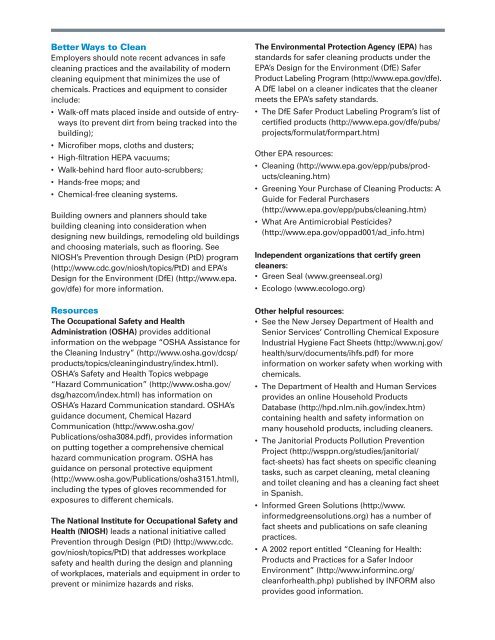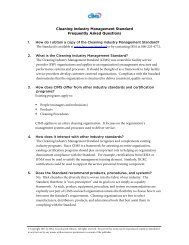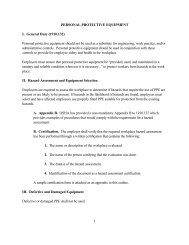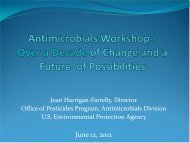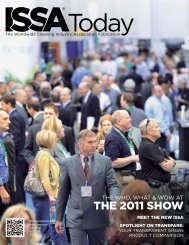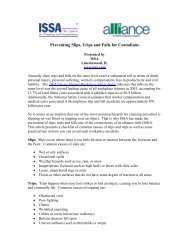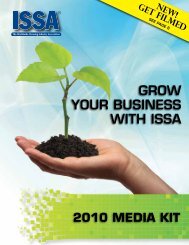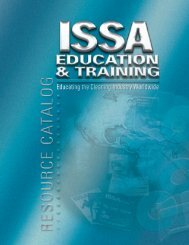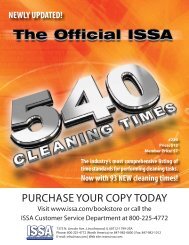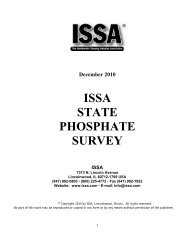Protecting Workers Who Use Cleaning Chemicals - OSHA
Protecting Workers Who Use Cleaning Chemicals - OSHA
Protecting Workers Who Use Cleaning Chemicals - OSHA
Create successful ePaper yourself
Turn your PDF publications into a flip-book with our unique Google optimized e-Paper software.
Better Ways to Clean<br />
Employers should note recent advances in safe<br />
cleaning practices and the availability of modern<br />
cleaning equipment that minimizes the use of<br />
chemicals. Practices and equipment to consider<br />
include:<br />
• Walk-off mats placed inside and outside of entryways<br />
(to prevent dirt from being tracked into the<br />
building);<br />
• Microfiber mops, cloths and dusters;<br />
• High-filtration HEPA vacuums;<br />
• Walk-behind hard floor auto-scrubbers;<br />
• Hands-free mops; and<br />
• Chemical-free cleaning systems.<br />
Building owners and planners should take<br />
building cleaning into consideration when<br />
designing new buildings, remodeling old buildings<br />
and choosing materials, such as flooring. See<br />
NIOSH’s Prevention through Design (PtD) program<br />
(http://www.cdc.gov/niosh/topics/PtD) and EPA’s<br />
Design for the Environment (DfE) (http://www.epa.<br />
gov/dfe) for more information.<br />
Resources<br />
The Occupational Safety and Health<br />
Administration (<strong>OSHA</strong>) provides additional<br />
information on the webpage “<strong>OSHA</strong> Assistance for<br />
the <strong>Cleaning</strong> Industry” (http://www.osha.gov/dcsp/<br />
products/topics/cleaningindustry/index.html).<br />
<strong>OSHA</strong>’s Safety and Health Topics webpage<br />
“Hazard Communication” (http://www.osha.gov/<br />
dsg/hazcom/index.html) has information on<br />
<strong>OSHA</strong>’s Hazard Communication standard. <strong>OSHA</strong>’s<br />
guidance document, Chemical Hazard<br />
Communication (http://www.osha.gov/<br />
Publications/osha3084.pdf), provides information<br />
on putting together a comprehensive chemical<br />
hazard communication program. <strong>OSHA</strong> has<br />
guidance on personal protective equipment<br />
(http://www.osha.gov/Publications/osha3151.html),<br />
including the types of gloves recommended for<br />
exposures to different chemicals.<br />
The National Institute for Occupational Safety and<br />
Health (NIOSH) leads a national initiative called<br />
Prevention through Design (PtD) (http://www.cdc.<br />
gov/niosh/topics/PtD) that addresses workplace<br />
safety and health during the design and planning<br />
of workplaces, materials and equipment in order to<br />
prevent or minimize hazards and risks.<br />
The Environmental Protection Agency (EPA) has<br />
standards for safer cleaning products under the<br />
EPA’s Design for the Environment (DfE) Safer<br />
Product Labeling Program (http://www.epa.gov/dfe).<br />
A DfE label on a cleaner indicates that the cleaner<br />
meets the EPA’s safety standards.<br />
• The DfE Safer Product Labeling Program’s list of<br />
certified products (http://www.epa.gov/dfe/pubs/<br />
projects/formulat/formpart.htm)<br />
Other EPA resources:<br />
• <strong>Cleaning</strong> (http://www.epa.gov/epp/pubs/products/cleaning.htm)<br />
• Greening Your Purchase of <strong>Cleaning</strong> Products: A<br />
Guide for Federal Purchasers<br />
(http://www.epa.gov/epp/pubs/cleaning.htm)<br />
• What Are Antimicrobial Pesticides<br />
(http://www.epa.gov/oppad001/ad_info.htm)<br />
Independent organizations that certify green<br />
cleaners:<br />
• Green Seal (www.greenseal.org)<br />
• Ecologo (www.ecologo.org)<br />
Other helpful resources:<br />
• See the New Jersey Department of Health and<br />
Senior Services’ Controlling Chemical Exposure<br />
Industrial Hygiene Fact Sheets (http://www.nj.gov/<br />
health/surv/documents/ihfs.pdf) for more<br />
information on worker safety when working with<br />
chemicals.<br />
• The Department of Health and Human Services<br />
provides an online Household Products<br />
Database (http://hpd.nlm.nih.gov/index.htm)<br />
containing health and safety information on<br />
many household products, including cleaners.<br />
• The Janitorial Products Pollution Prevention<br />
Project (http://wsppn.org/studies/janitorial/<br />
fact-sheets) has fact sheets on specific cleaning<br />
tasks, such as carpet cleaning, metal cleaning<br />
and toilet cleaning and has a cleaning fact sheet<br />
in Spanish.<br />
• Informed Green Solutions (http://www.<br />
informedgreensolutions.org) has a number of<br />
fact sheets and publications on safe cleaning<br />
practices.<br />
• A 2002 report entitled “<strong>Cleaning</strong> for Health:<br />
Products and Practices for a Safer Indoor<br />
Environment” (http://www.informinc.org/<br />
cleanforhealth.php) published by INFORM also<br />
provides good information.


